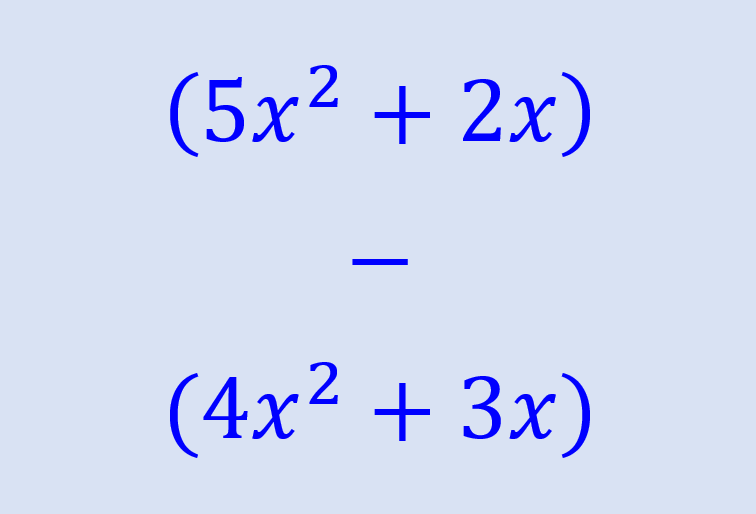Polynomial subtraction is one of the easiest mathematical operations that we can perform with polynomials. To perform subtraction of polynomials, we have to identify like terms and subtract the coefficients of the like terms.
Here, we will look at a summary of the subtraction of polynomials and the process used. In addition, we will look at several examples with answers of subtraction of polynomials in order to fully master this topic.
Summary of subtraction of polynomials
To subtract two or more polynomials, we just have to combine like terms and consider the order of operations. Something important that must be taken into account is to distinguish the terms with “plus” and “minus” signs in each polynomial.
We follow the following steps to subtract polynomials:
Step 1: Remove all parentheses. To facilitate visualization, it is advisable to write the problem and each process vertically. When we remove the parentheses, we have to distribute the negative sign, which will cause each of the terms to change the sign.
Step 2: Combine like terms. If we write the steps vertically, combining like terms is easier. Remember that like terms are terms that have the same variables with the same exponents.
Subtraction of polynomials – Examples with answers
The following examples have their respective solutions, so you can study them carefully and master the process of simplifying algebraic expressions.
EXAMPLE 1
Solve the subtraction of polynomials: $latex (6x+8y)-(3x-2y)$.
Solution
We have to remove the parentheses. To do this, we have to take into account the negative sign in front of the second polynomial, so we change the sign of all the terms of the second polynomial. Then, we have to group like terms:
$latex (6x+8y)-(3x-2y)$
$latex =6x+8y-3x+2y$
$latex =6x-3x+8y+2y$
$latex =3x+10y$
These terms are no longer similar since they do not have the same variable, so we cannot combine them.
EXAMPLE 2
Solve the subtraction $latex (6x+8y)-(3x-2y)$ vertically.
Solution
We can subtract polynomials vertically by placing each variable in its own column. Therefore, we use the first column for x and the second for y. Since we are subtracting the second polynomial, we have to change the sign of all its terms:
$latex 6x+8y$
$latex -3x+2y$
___________
$latex 3x+10y$
Clearly, we got the same answer as when we subtracted horizontally. It is possible to solve the subtraction of polynomials using any format. Just choose the format with which you feel most comfortable.
Generally, when we have simple polynomials, the horizontal format is easier. However, for longer and more complicated polynomials, subtracting vertically can make the process easier.
EXAMPLE 3
Solve the subtraction of polynomials: $$(4{{x}^3}+2{{x}^2}-4x+6)-(2{{x}^3}+4{{x}^2}+6x-7)$$
Solution
We can start by performing the subtraction horizontally. Therefore, we remove the parentheses taking into account the “minus” sign and then combine like terms:
$$(4{{x}^3}+2{{x}^2}-4x+6)-(2{{x}^3}+4{{x}^2}+6x-7)$$
$$=4{{x}^3}+2{{x}^2}-4x+6-2{{x}^3}-4{{x}^2}-6x+7$$
$$=4{{x}^3}-2{{x}^3}+2{{x}^2}-4{{x}^2}-4x-6x+6+7$$
$latex =2{{x}^3}-2{{x}^2}-10x+13$
Now, we can perform the subtraction vertically. We separate each exponent by columns and change the sign of all the terms of the second polynomial since we have the “minus” sign in front:
$latex 4{{x}^3}+2{{x}^2}-4x+6$
$latex -2{{x}^3}-4{{x}^2}-6x+7$
___________________
$latex 2{{x}^3}-2{{x}^2}-10x+13$
EXAMPLE 4
Solve the subtraction $$(-5{{x}^3}+6{{x}^2}-4x)-(3{{x}^3}-5{{x}^2}-6x)$$
Solution
We are going to perform the subtraction horizontally. Therefore, we remove the parentheses by changing the signs of the terms of the second polynomial since they have the “minus” sign in front of them. Then we simplify by combining like terms:
$$(-5{{x}^3}+6{{x}^2}-4x)-(3{{x}^3}-5{{x}^2}-6x)$$
$$=-5{{x}^3}+6{{x}^2}-4x-3{{x}^3}+5{{x}^2}+6x$$
$$=-5{{x}^3}-3{{x}^3}+6{{x}^2}+5{{x}^2}-4x+6x$$
$latex =-8{{x}^3}+11{{x}^2}+2x$
Now, we perform the subtraction vertically. We have to assign a column to each exponent and we have to change the sign to the terms of the second polynomial:
$latex -5{{x}^3}+6{{x}^2}-4x$
$latex -3{{x}^3}+5{{x}^2}+6x$
________________
$latex -8{{x}^3}+11{{x}^2}+2x$
EXAMPLE 5
Solve the following operation: $latex (4{{x}^2}+2x-5)-(5{{x}^2}-4x-4)$ $latex -(-6{{x}^2}+3x+10)$.
Solution
In this case, it will be easier if we solve the subtraction of polynomials using the vertical format. We separate the variables in different columns depending on the exponent and change the sign of all the terms of the polynomials that are being subtracted:
$latex 4{{x}^2}+2x-5$
$latex -5{{x}^2}+4x+4$
$latex 6{{x}^2}-3x-10$
________________
$latex 5{{x}^2}+3x-11$
Subtraction of polynomials – Practice problems
Practice subtraction of polynomials with the following problems. Solve the subtractions and choose your answer. Click “Check” to verify that you selected the correct answer.
See also
Interested in learning more about operations with polynomials? Take a look at these pages:




